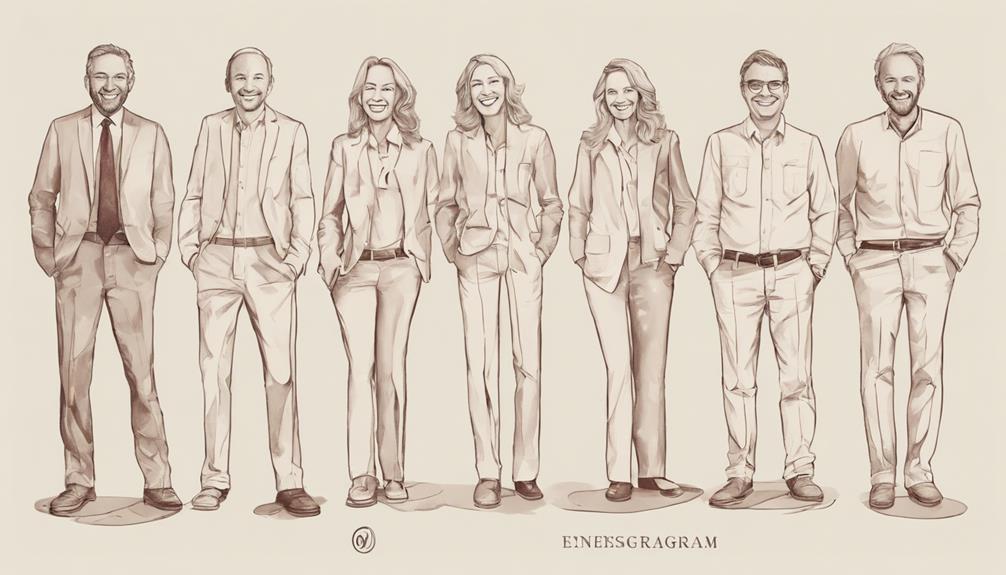Have you ever thought about the various manifestations of Enneagram Type 6?
The three subtypes offer distinct perspectives on loyalty, fear, and trust.
As we explore the intricate variations within Enneagram 6, a deeper understanding of these subtypes emerges.
Stay tuned to uncover the nuanced behaviors and motivations that drive each subtype, shedding light on the complexities of the Type 6 personality.
Key Takeaways
- Enneagram 6 subtypes include Loyalty, Guardian, and Troubleshooter variations.
- Each subtype emphasizes different priorities like security, support, and problem-solving.
- Understanding nuances aids in self-awareness and personal growth paths.
- Subtypes offer profound insights into instinctual focuses and distinct behavior patterns.
Understanding Enneagram 6 Subtypes
Understanding the Enneagram 6 Subtypes offers a profound insight into the diverse instinctual focuses and behavioral tendencies that characterize each variation of this personality type. Enneagram 6 subtypes, namely Self-Preservation, One to One (Sexual), and Social variations, provide a lens through which we can discern the nuanced differences in how individuals of this type navigate the world.
Each subtype emphasizes distinct priorities, such as seeking security and protection for Self-Preservation 6s, displaying strength and independence for One to One 6s, and adhering to external guidelines and values for Social 6s. By delving into the intricacies of these subtypes, individuals can gain a deeper understanding of their own personalities, growth paths, and Enneagram types.
Recognizing these variations not only sheds light on our motivations and fears but also aids in fostering self-awareness and personal development by pinpointing specific patterns of behavior and thought unique to each subtype.
Loyalty Subtype Characteristics

Exploring the Loyalty subtype characteristics of Enneagram 6 individuals reveals a deep-seated need for security and loyalty within their interpersonal relationships. These individuals prioritize trust and reliability, often struggling with doubts and anxiety while seeking reassurance and stability. Dedicated and committed, they value loyalty and support from their social circle, emphasizing the importance of building strong relationships based on trust and allegiance. The journey towards personal growth for Loyalty subtypes involves cultivating a sense of inner security and learning to manage their fears effectively. Developing a deeper understanding of themselves and their needs can lead to more profound connections with others, fostering a sense of stability and trust in their relationships. By acknowledging their anxieties and working on building self-assurance, Loyalty subtypes can navigate their interpersonal dynamics with greater confidence and authenticity.
| Trust | Loyalty | Personal Growth |
|---|---|---|
| High | Strong | Continuous |
Guardian Subtype Behaviors
Guardian subtypes in Enneagram 6 demonstrate a steadfast commitment to providing security and support for those in their social circles, embodying traits of loyalty, reliability, and a protective nature. These individuals often grapple with a deep-rooted lack of trust, leading them to seek to understand the intentions of those around them meticulously. Guardians approach relationships with a keen sense of loyalty and dedication, always taking care to ensure the well-being of their loved ones.
Their protective instincts drive them to anticipate potential risks and actively work to mitigate them, creating a sense of safety and stability within their social circles. By building strong connections and networks, Guardian Sixes foster an environment where trust can flourish, and those around them feel secure. Through their unwavering support and commitment, Guardian subtypes play a vital role in nurturing relationships and safeguarding the emotional and physical well-being of those they hold dear.
Troubleshooter Subtype Traits

With a laser-like focus on identifying potential challenges and threats, Troubleshooter subtypes of Enneagram 6 demonstrate unparalleled vigilance in anticipating and mitigating risks within their surroundings. Type Sixes using the Enneagram take charge by relying on their keen observation and problem-solving abilities to navigate uncertain situations with caution. They excel in crisis management, strategizing to minimize risks and ensure safety for themselves and others. These individuals exhibit a strong sense of responsibility and dedication to resolving issues efficiently, often serving as reliable problem-solvers in their social circles.
| Traits | Description | Example |
|---|---|---|
| Proactive | Anticipates dangers ahead of time and takes preemptive action to address potential challenges. | Researching emergency procedures before traveling. |
| Analytical | Utilizes analytical skills to evaluate situations and develop effective strategies for problem-solving. | Conducting a thorough risk assessment before making decisions. |
| Reliable | Demonstrates a high level of dependability in resolving issues, offering support and solutions to those in need. | Being the go-to person for troubleshooting technical problems in the workplace. |
Unveiling Enneagram 6 Variations
Delving into the diverse Enneagram 6 variations sheds light on the intricate nuances that shape individual behaviors and motivations within this personality type. Understanding the variations among Enneagram 6 subtypes provides deeper insights into individual behaviors and motivations within the type. Here is a breakdown that reveals the complexities of these variations:
- Self-Preservation 6s: These individuals have a strong desire for security, seeking support and protection within their close relationships and family unit. They often prioritize safety and stability, displaying a cautious approach to life.
- One to One (Sexual) 6s: This subtype takes a counter-phobic stance, valuing strength and independence. They exhibit a cynical lack of trust in human nature, often questioning the intentions of others.
- Social 6s: Advocates for values and rules, these individuals rely on external guidelines to navigate life. They fear disapproval and strive to do the right thing within their social circles.
- Type Two Influence: Enneagram 6s, influenced by Type Two characteristics, often take care of others to alleviate their own anxieties and insecurities, fostering a sense of safety through helping those around them.
Frequently Asked Questions
What Are the Three Subtypes of Enneagram 6?
The three subtypes of Enneagram 6 are Self-Preservation, One to One (Sexual), and Social. Each subtype brings a unique focus to the core fears and desires of Enneagram 6 individuals.
Self-Preservation 6s prioritize security, One to One 6s emphasize strength, and Social 6s seek confidence through external guidelines.
Understanding these distinctions can deepen our insights into the motivations and behaviors of Enneagram 6 personalities.
What Is the Difference Between Social 6 and Self Preservation 6?
When comparing Social 6 and Self-Preservation 6, we see distinct differences. Social 6s seek security through group affiliations and external guidance, while Self-Preservation 6s prioritize personal safety in their immediate environment.
Social 6s rely on social structures for reassurance, whereas Self-Preservation 6s focus on physical security. The former fear being unsupported by their community, while the latter fear personal harm.
These variances highlight unique approaches to seeking security and stability.
What Are the Three Subtypes of the Enneatype?
The three subtypes of the Enneatype are Self-Preservation, One to One (Sexual), and Social. Each subtype highlights specific instinctual focuses and patterns within the core type's behavior.
Self-Preservation 6s seek security, One to One 6s focus on strength, and Social 6s look to external guidelines for confidence. Understanding these nuances offers deeper insights into Enneatype 6 motivations and behaviors, enhancing self-awareness and growth opportunities.
What Is a Counterphobic 6 Subtype?
Counterphobic 6 subtype embodies a bold, confrontational attitude towards fears. We confront anxieties directly, proving our courage and strength.
Risk-taking and challenging situations are embraced to defy fears. Our tough exterior masks inner insecurities.
Strength and defiance combat doubts within us.
What Are the Subtypes of Enneagram 6 and How Do They Differ?
Enneagram Type 6 has two subtypes: phobic and counterphobic. The phobic 6 tends to avoid confrontations and seek security, while the counterphobic 6 tends to confront their fears and be more rebellious. This is what makes Enneagram types unique – their distinct reactions and coping mechanisms.
Conclusion
In conclusion, the intricate dance of the Enneagram 6 subtypes reveals a tapestry of loyalty, guardianship, and troubleshooter tendencies.
As we unravel the layers of these variations, we're met with a comical yet profound realization of the human condition.
Through the lens of satire, we see how our fears and insecurities manifest in different ways, ultimately leading us on a journey of self-discovery and growth.
Embrace the absurdity and complexity of the Enneagram 6 subtypes, for they hold the keys to unlocking our true selves.
Felicity, our Author, pens in-depth articles and guides that delve into the heart of personal discovery. Her narrative-driven approach weaves together theory, practice, and personal anecdotes, making the journey of self-exploration both relatable and inspiring. Felicity’s contributions help illuminate the path for those seeking a deeper understanding of themselves and their relationships.










